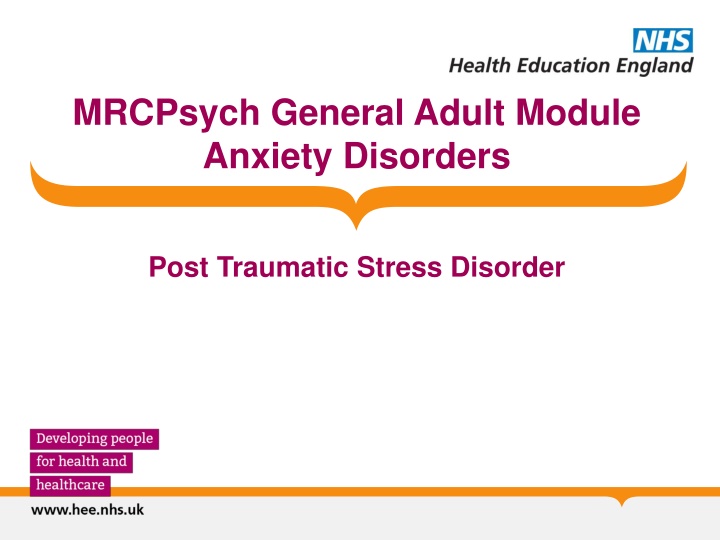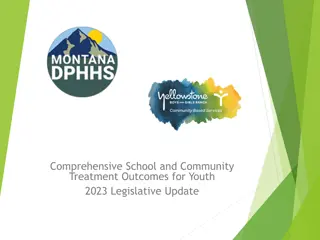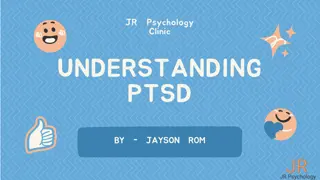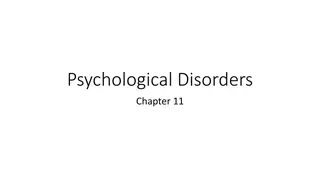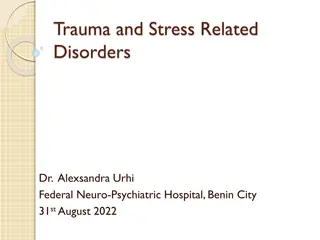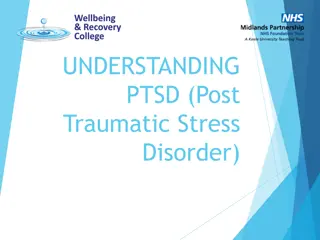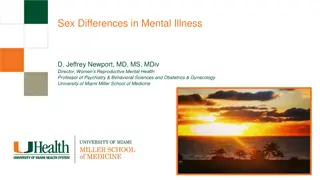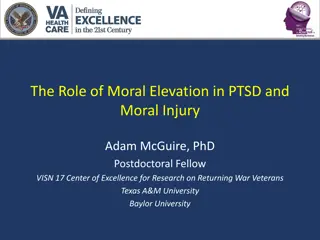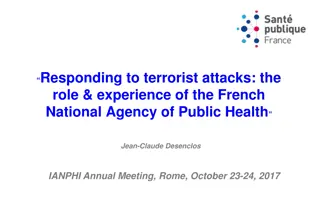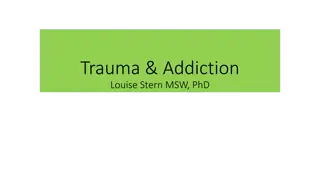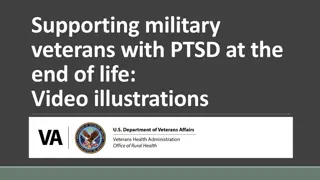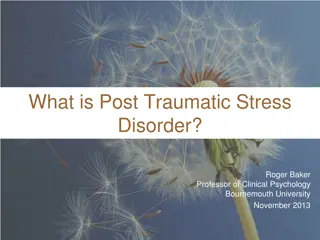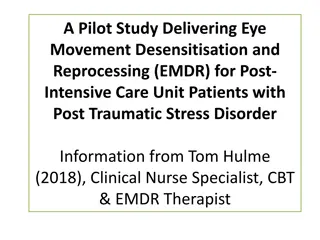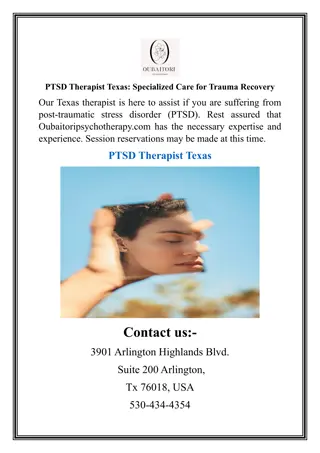PTSD: A Comprehensive Overview
An in-depth exploration of PTSD covering its history, diagnostic criteria, and management strategies, including pharmacological, psychological, and social interventions. Delve into the aetiology, epidemiology, neurobiology, and clinical presentations, while also developing skills to critically appraise meta-analyses and systematic reviews. Discover the evolution of PTSD from the American Civil War to modern-day understanding and treatment modalities.
Download Presentation

Please find below an Image/Link to download the presentation.
The content on the website is provided AS IS for your information and personal use only. It may not be sold, licensed, or shared on other websites without obtaining consent from the author.If you encounter any issues during the download, it is possible that the publisher has removed the file from their server.
You are allowed to download the files provided on this website for personal or commercial use, subject to the condition that they are used lawfully. All files are the property of their respective owners.
The content on the website is provided AS IS for your information and personal use only. It may not be sold, licensed, or shared on other websites without obtaining consent from the author.
E N D
Presentation Transcript
MRCPsych General Adult Module Anxiety Disorders Post Traumatic Stress Disorder
Post Traumatic Stress Disorder Aims and Objectives To develop an understanding of PTSD (aetiology, epidemiology, natural history, neurobiology, genetics, diagnostic criteria, classification, psychopathology, clinical presentation, assessment, risks) and its management (pharmacological, psychological, social). To develop an understanding of Meta-analyses and Systematic Reviews and develop skills for critically appraising them.
Post Traumatic Stress Disorder To achieve this Case Presentation Journal Club 555 Presentation Expert-Led Session MCQs Please sign the register and complete the feedback
PTSD A brief history American Civil War Irritable heart WW1 Shell shock / Effort syndrome 13000 Cases of shell shock. Increased to 200000 by 1918 307 soldiers executed for cowardice Vietnam War brought in concept of PTSD Gulf War Gulf war syndrome 1980 - the American Psychiatric Association added PTSD to DSM-III
PTSD - Definition An anxiety disorder precipitated by an experience of intense fear or horror while exposed to a traumatic (especially life-threatening) event. The disorder is characterised by intrusive recurring thoughts or images of the traumatic event; avoidance of anything associated with the event; a state of hyperarousal and diminished emotional responsiveness. These symptoms are present for at least one month
PTSD Diagnostic Criteria Criterion A: stressor Exposure to a stressor Criterion B: re- experiencing Persistent remembering of the stressor in one of: Intrusive flashbacks Vivid memories or recurring dreams Experiencing distress when reminded of the stressor Criterion C: avoidance Actual or preferred avoidance of circumstances resembling or associated with the stressor (not present before the stressor). Criterion D: hyperarousal (either D1 or D2) D1: Inability to recall Sleep problems Irritability Concentration problems Hypervigilance Exaggerated startle response D2: Two or more of: Onset of symptoms within six months of the stressor. Criterion E: time
PTSD Differences between ICD and DSM diagnosing criteria Criterion A: stressor subjective stress DSM V includes Avoidance - avoid thoughts, feelings, or conversations about the traumatic event. Avoid places or people that remind of the traumatic event. Criterion C: avoidance DSM V includes emotional numbing and avoidance symptoms Numbing - Loss of interest in once pleasurable activities, feeling distant from others, experiencing difficulties having positive feelings DSM V any two symptoms from D1 and D2 Criterion D: hyperarousal Criterion E: time DSM V specifies symptoms to be presemt for over a month.
PTSD Formal Assessment Tools IES - R Clinician Administered PTSD Scale (CAPS) developed by National Center for PTSD requests information about the frequency and intensity of the core PTSD symptoms and common associated symptoms. Treatment Outcome PTSD scale (TOP 8) It is shorter, is easier to use, and is highly correlated with the CAPS. Structured Interview for PTSD (SI-PTSD) PTSD Symptom Scale Interview (PSS-I)
PTSD - Epidemiology Prevalence Military - 4.8%1 General population 25 30% of people experiencing a traumatic event may go on to develop PTSD. 2.6% in men 3.3% in women2 1 in 5 firefighters. 1 in 3 teenage survivors of car crashes. 1 in 2 female rape victims. 2 in 3 prisoners of war. 1. 2. Iversen et al. The prevalence of common mental disorders and PTSD in the UK military: using data from a clinical interview-based study BMC Psychiatry 2009, 9:68 McManus et al. Adult Psychiatric Morbidity in England, 2007 - Results of a household survey, The NHS Information Centre for health and social care
Modern day PTSD Referrals to victim support in UK 0.10% Homocide and road deaths Rape andsexual crimes 1.40% 0.70% 5% 11% 20% Other violence Burglary Theft 22% criminal damamge and arson Other crime 40% Other referrals
PTSD Risk Factors All Past psychiatric history, neuroticism Military: Duration of combat exposure / trauma experienced up close. Poor social support. Bullying Lower rank Low educational attainment. History of childhood adversity. Females Twice as likely to develop PTSD as men. Women were more vulnerable to PTSD after disasters and accidents, followed by loss and non-malignant diseases. 1-2% of women suffer from PTSD postnatally3. 3. Anderson et al. Risk factors for developing post-traumatic stress disorder following childbirth: a systematic review. Acta Obstet Gynecol Scand. 2012
PTSD Comorbidity Depressive disorder Substance misuse and dependence Anxiety disorder Bi-polar disorder Note: patients with PTSD are known to have poor compliance with medication4. 4. Kronish et al. Post-traumatic stress disorder and medication adherence: results from the Mind Your Heart Study. J Psychiatr Res. 2012 Dec;46(12):1595-9. 5. Chart - Kessler & Sonnega, et al. Arch Gen Psychiatry. 1995;52(12):1048-1060.
PTSD Aetiology : Theories Neurobiology Structural brain imaging - reduced volume of the hippocampus, prefrontal lobe and anterior cingulate. Functional brain imaging suggests excessive amygdala activity and reduced activation of the prefrontal cortex and hippocampus Neurochemical Increased dopamine, Increased NA, Decreased 5HT in dorsal and median raphe. Genetic polymorphism in the DA transporter gene excess of the SLC6A39 repeat allele Neuroendocrine hypocortisolism Sustained raised CRH Increased T3:T4 Nemeroff CB. Post-traumatic stress disorder: the neurobiological impact of psychological trauma. Dialogues in Clinical Neuroscience 2011;13(3):263-278.
Brain Regions Implicated in the Pathophysiology of Post-Traumatic Stress Disorder (PTSD). Shown are the known connectivity paths within four dysfunctional circuits that play a part in the psychopathology of PTSD: Emotion regulation and executive function, Threat detection, Contextual processing, Fear learning.
PTSD Psychodynamic Theory Subjective meaning of a stressor may determine its traumatogenicity Traumatic events may resonate childhood traumas Common defenses Denial Minimisation Splitting Projective identification Dissociation Guilt Object relatedness projection and interojection
PTSD Cognitive Theory Mowrer s two factor conditioning theory Traumatic stimuli Maintains problem Fear and Arousal Negative re- enforcement by operant conditioning Stimulus generalisation by classical conditioning Avoidance
PTSD Differential Diagnoses Acute stress disorder In general, the symptoms of acute stress disorder must occur within four weeks of a traumatic event and come to an end within that four-week time period. If symptoms last longer than one month and follow other patterns common to PTSD, the diagnosis may change from acute stress disorder to PTSD. OCD Both have recurrent, intrusive thoughts as a symptom Thoughts present in obsessive-compulsive disorder do not usually relate to a past traumatic event. Adjustment disorder Similar to adjustment disorder because both are linked with anxiety that develops after exposure to a stressor. With PTSD, this stressor is a traumatic event. With adjustment disorder, the stressor does not have to be severe or outside the normal human experience. Other comorbid conditions are also differentials
PTSD - Treatment If co-morbid depression treat PTSD first Substance misuse addressed before PTSD Education patient and carers Symptoms of PTSD Common reactions to trauma Giving up behaviours that continue avoidance First line - psychological
PTSD - Treatment Evidence for treatment Produced by the National Center for PTSD, U.S. Department of Veterans Affairs | February 2011 Treatment Effect size (effect size of 0.8 is considered large. Everyone would notice it. ) Confidence interval Prolonged exposure EMDR Cognitive processing Therapy SSRI 1.91 1.89 1.81 1.52 2.3 1.07 2.71 1.41 2.21 1.64 1.13 2.16 http://www.ptsd.va.gov/Public/understanding_TX/CourseList/Course_NCPTSD_Treatment_1435/assets/000 15006.PDF
PTSD Treatment Psychological Debriefing Self help Trauma focused CBT Exposure therapy Imaginal exposure - flooding In vivo exposure visiting trauma site Cognitive restructuring make sense of the bad memories - people remember the event differently than how it happened. May feel guilt or shame about what is not their fault Stress inoculation training Relaxation methods
PTSD Treatment EMDR Even the most enthusiastic supporters of EMDR have not agreed on how the therapy works! Incorporates many different interventions, imaginal exposure (under conditions of divided attention) free association, The main intervention requires the patient to recall trauma-related memories while focusing on external oscillatory stimulation. Stimulation is induced by the therapist moving a finger from side to side across the patient's field of vision, which induces eye movements. 24 eye moments = 1 set Sets of eye movements are induced until distress is reduced.
EMDR A few years ago I underwent EMDR. I was sceptical, of course. At this point in time, however, I see that it saved my marriage, my sanity and my relationship with my children. I was suffering from PTSD after experiencing much loss and never even realized that's what stood in the way of a healthy life. It's a wonderful treatment and more people should be informed about it. I was lucky to run across it by accident. Thank you, J.M. I was a member of the Canadian Army for over 20 years. I suffered from OSI (operational stress injury), depression, and the loss of my daughter and wife killed by a drunk driver. For over a year of treatment and work on my part I have finally found some peace of mind, My anger and depression had lowered to a manageable level. Today, I see the light at the end of the tunnel.... I know that this treatment EMDR is by far the best I ever received in the mental health field, and the great thing is no meds. Thank you, G.C.
PTSD Treatment Medication Third line minimal Second line: Venelafaxine Mirtazepine Trazodone TCA chlomipramine MAOIs Phenelzine Propanolol For somatic symptoms evidenceAntipsychotics Topiramate Carbamezapine Lamotrigine Alpha1 receptor antaonist Prazosin SSRI : Sertraline Paroxetine (not commonly used) First line Minimal evidence for Risperidone
NICE guidelines outline Symptoms present for more than 3 months after trauma: 1st line- EMDR or trauma-focused CBT. Drug treatment : not routine 1st line Paroxetine or Mirtazapine (general use) Amitriptyline or Phenelzine (under specialist care)
PTSD - Prognosis Untreated 30% of patients recover completely With treatment After 1 year 50% of patients recover completely (66%) 30% have mild symptoms 10% have moderate symptoms 10% have same symptoms or become worse
PTSD - Prognosis Positive prognostic factors Robust premorbid personality Above average cognitive ability Good social skills Negative prognostic factors Children Very old Past psychiatric history personality disorder anxiety disorder Female Strong social support Absence of past psychiatric/medical history Absence of alcohol / substance misuse/dependency Optimism Environmental stability Less severe trauma Early intervention Minimal duration of trauma Trauma not experienced up close
Post Traumatic Stress Disorder MCQs 1. Which of the following psychological interventions can be effective for the treatment of post-traumatic stress symptoms in children and young people who have been sexually abused? A. Psychodynamic psychotherapy B. CAT C. Trauma focused CBT D. IPT E. Single episode debrief
Post Traumatic Stress Disorder MCQs 1. Which of the following psychological interventions can be effective for the treatment of post-traumatic stress symptoms in children and young people who have been sexually abused? A. Psychodynamic psychotherapy B. CAT C. Trauma focused CBT D. IPT E. Single episode debrief
Post Traumatic Stress Disorder MCQs 2. Which antidepressant is licensed for the treatment of PTSD? A. Sertraline B. Mirtazapine C. Venlafaxine D. Amitriptyline E. Moclobemide
Post Traumatic Stress Disorder MCQs 2. Which antidepressant is licensed for the treatment of PTSD? A. Sertraline B. Mirtazapine C. Venlafaxine D. Amitriptyline E. Moclobemide And paroxetine
Post Traumatic Stress Disorder MCQs 3. Which of the following is NOT a DSM V symptom of PTSD? A. Persistent negative beliefs about oneself B. Persistent pain C. Self-destructive or reckless behaviour D. Constricted affect E. Marked diminished interest in (pre-traumatic) significant activities
Post Traumatic Stress Disorder MCQs 3. Which of the following is NOT a DSM V symptom of PTSD? A. Persistent negative beliefs about oneself B. Persistent pain C. Self-destructive or reckless behaviour D. Constricted affect E. Marked diminished interest in (pre-traumatic) significant activities
Post Traumatic Stress Disorder MCQs 4. Which of these statements is true regarding acute stress reaction and PTSD? A. Acute stress disorder only occurs in the elderly population and children B. Acute stress disorder describes symptoms in someone who was not present at an incident, while PTSD takes place only in those who were present C. PTSD is not diagnosed until after 4 weeks following the traumatic event D. Acute stress disorder and PTSD can be diagnosed at any time after the stressful event E. All acute stress disorder patients develop PTSD
Post Traumatic Stress Disorder MCQs 4. Which of these statements is true regarding acute stress reaction and PTSD? A. Acute stress disorder only occurs in the elderly population and children B. Acute stress disorder describes symptoms in someone who was not present at an incident, while PTSD takes place only in those who were present C. PTSD is not diagnosed until after 4 weeks following the traumatic event D. Acute stress disorder and PTSD can be diagnosed at any time after the stressful event E. All acute stress disorder patients develop PTSD
Post Traumatic Stress Disorder MCQs 5. Which of the following is recommended as first line treatment for PTSD in adults? A. Mirtazapine B. EMDR C. Phenelzine D. Psychodynamic psychotherapy E. Sertraline
Post Traumatic Stress Disorder MCQs 5. Which of the following is recommended as first line treatment for PTSD in adults? A. Mirtazapine B. EMDR C. Phenelzine D. Psychodynamic psychotherapy E. Sertraline
Post Traumatic Stress Disorder References 1. Iversen et al. The prevalence of common mental disorders and PTSD in the UK military: using data from a clinical interview-based study BMC Psychiatry 2009, 9:68 2. McManus et al. Adult Psychiatric Morbidity in England, 2007 - Results of a household survey, The NHS Information Centre for health and social care 3. Anderson et al. Risk factors for developing post-traumatic stress disorder following childbirth: a systematic review. Acta Obstet Gynecol Scand. 2012 4. Kronish et al. Post-traumatic stress disorder and medication adherence: results from the Mind Your Heart Study. J Psychiatr Res. 2012 Dec;46(12):1595-9. 5. Chart - Kessler & Sonnega, et al. Arch Gen Psychiatry. 1995;52(12):1048- 1060. 6. Shalev et al. N Engl J Med 2017;376:2459-69.
Post Traumatic Stress Disorder Any Questions? Thank you.
